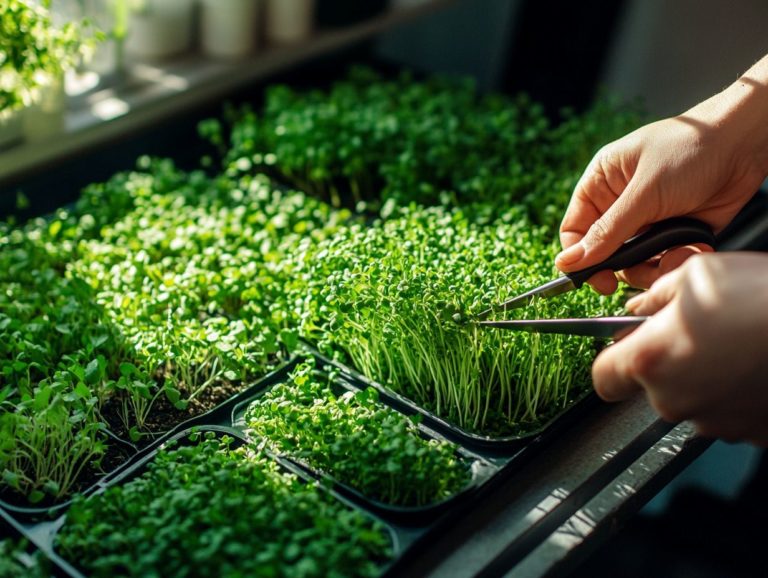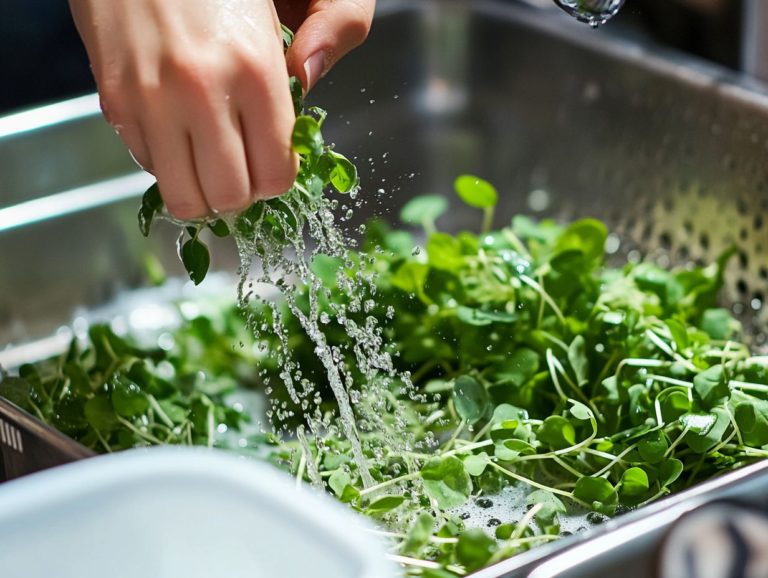How to Identify When Microgreens Are Overripe
Microgreens are a vibrant addition to your plate, providing a delightful blend of flavor and nutrition in a compact form.
Recognizing when these delicate greens become overripe can transform your culinary experience from a potential delight to one that falls short of expectations.
You ll discover the visual cues, along with texture and taste changes, that indicate microgreens have surpassed their prime.
You ll learn the common causes of overripeness, best practices for prevention, and inventive ways to incorporate these greens into your meals.
Whether you re a seasoned gardener or an eager cook, grasping these nuances will elevate your journey with microgreens.
Contents
- Key Takeaways:
- Signs of Overripe Microgreens
- Causes of Overripe Microgreens
- Preventing Overripe Microgreens
- Uses for Overripe Microgreens
- Frequently Asked Questions
- 1. How do I know when my microgreens are overripe?
- 2. Can I still eat my microgreens if they are overripe?
- 3. What causes microgreens to become overripe?
- 4. Are some types of microgreens more prone to becoming overripe?
- 5. How can I prevent my microgreens from becoming overripe?
- 6. Can I use overripe microgreens in my compost?
Key Takeaways:

- Pay attention to visual indicators such as wilting, yellowing, or discoloration to identify overripe microgreens.
- Changes in texture and taste can also indicate overripe microgreens, such as a slimy or bitter taste.
- Prevent overripe microgreens by following best practices for growing, harvesting, and storing them properly.
What are Microgreens?
Microgreens are an opportunity for a nutrition-packed culinary experience, harvested at their prime young stage typically between 7 to 21 days after germination.
These tiny powerhouses are amazing! Varieties like peas, sunflowers, coriander, and arugula are not just a feast for the eyes with their vibrant colors, but they also deliver bold flavors while being loaded with essential vitamins and minerals. It’s no wonder that cooking lovers and microgreens growers have fully embraced their versatility in both cooking and health.
Microgreens not only taste great, but they are also packed with nutrients, often boasting higher concentrations of essential nutrients than their fully grown counterparts.
Rich in vitamins A, C, E, and K, these little greens also offer a wealth of healthy plant compounds that contribute to your overall well-being.
If you re looking to cultivate your own microgreens, using the right growing medium the material where plants grow, like soil or water is crucial for supporting root hairs and ensuring optimal development.
Varieties like radish, mustard, and broccoli not only introduce exciting flavors, but they also provide a range of health benefits, giving you plenty of options to choose from.
Research from Kansas State University offers insightful guidelines for maximizing your yields, emphasizing the significance of light exposure and proper watering techniques to help your microgreen garden flourish.
Signs of Overripe Microgreens
Detecting overripe microgreens is essential for both home and commercial growers seeking to maintain the highest quality and flavor. You should be on the lookout for several signs that indicate your microgreens may be past their prime.
Visual cues, along with changes in texture and taste, can provide valuable insights. Overripe microgreens often appear leggy, stretched out, or tall, which can indicate poor light conditions, lose their vibrant colors, and may develop an undesirable bitter taste. To avoid these issues, understanding microgreen harvest timing is essential, as many problems can often be traced back to environmental conditions, such as elevated humidity levels or insufficient airflow during their growth.
Visual Indicators
The visual indicators of overripe microgreens can be quite telling for you; your plants may exhibit signs of wilting, yellowing leaves, or excessive droopiness, often worsened by inadequate drainage holes in their growing containers.
Recognizing these symptoms early allows you to take corrective action, potentially salvaging your microgreens before they reach a point of no return.
Proper drainage is essential, as it prevents water from pooling at the bottom of the container, which can lead to root rot and other harmful conditions.
Different seed varieties also show unique signs of overripeness; for example, some may develop a flimsy texture or dark spots, while others might bolt prematurely. By observing the variations in growth patterns, you can better understand the specific needs of each variety, allowing you to adjust your care accordingly.
By understanding these visual cues, you’ll not only improve your yield but also make your microgreens even better!
Texture and Taste Changes

As microgreens age, their texture can shift dramatically. This change can lead to a tough or woody consistency.
You might also notice taste changes, like bitterness. These signs indicate that your microgreens are overripe.
These transformations often stem from poor airflow during growth. This can negatively impact the overall quality and taste of your microgreens.
Keep a close eye on ripeness to preserve their appeal and flavor. Stagnant air can significantly diminish the crispness of those tender leaves.
To achieve optimal quality, ensure proper ventilation. Consider techniques like vertical growing systems ways to grow plants upward instead of outward, which saves space or using oscillating fans.
Color assessment is key here. Vibrant hues usually indicate freshness, while dull tones can signal a decline in quality.
By grasping how these factors interconnect, you can master the timing of your harvest. You are ensuring your culinary experience is nothing short of delightful!
Causes of Overripe Microgreens
Understanding the causes of overripe microgreens is crucial for you as a grower striving to optimize both the amount of plants you grow and quality.
Overripe microgreens often stem from environmental factors. These include excess moisture, not enough airflow, and improper harvesting techniques. These conditions create a damp environment that encourages mold growth and diminishes the overall health of your plants.
Environmental Factors
Environmental factors significantly impact the health and quality of your microgreens. If you find yourself dealing with excessive moisture and poor airflow, you might be setting the stage for mold growth, which can lead to overripe microgreens.
Keeping humidity levels in check is essential for preventing these unfavorable conditions while promoting robust growth.
Excess moisture can quickly become a breeding ground for various pathogens. This hinders plant development and ultimately affects your overall yield.
Inadequate airflow can make matters worse, trapping humidity and heat both of which are harmful to your plants.
High humidity levels can cause seedlings to stretch awkwardly toward light sources. This results in weak stems. To counter these challenges, it’s wise to implement proper ventilation, use well-draining soil, and regularly monitor moisture levels.
By adopting these strategies, you create an environment where your microgreens can truly flourish, enhancing their flavor and nutritional content!
Harvesting Techniques
Implementing proper harvesting techniques is essential for you to maintain the quality of your microgreens. Incorrect methods can lead to damage and accelerate the transition to overripe microgreens.
Utilizing clean equipment and ensuring optimal growing conditions particularly through proper lighting can significantly enhance both the shelf life and flavor of your harvested microgreens.
Understanding the nuances of timing is just as crucial as the method itself. Cutting microgreens at the right moment typically just above the soil line helps preserve their delicate flavor profile and nutritional benefits.
Using sterilized scissors or sharp knives minimizes contamination and prevents the spread of diseases that could compromise the health of your other crops.
Regular maintenance of your tools promotes hygienic practices and ensures precision, leading to a cleaner cut.
By incorporating these best practices into your microgreens harvesting process, you can achieve a superior product that appeals to discerning customers while maximizing both flavor and shelf life!
Preventing Overripe Microgreens

Preventing overripe microgreens is essential for your success, whether you’re an enthusiastic amateur or a seasoned commercial grower.
By following best practices such as carefully monitoring humidity levels, ensuring proper air circulation, and selecting the right seed varieties like MP SEEDS you can significantly reduce the risk and enjoy a thriving harvest!
This attention to detail will elevate the quality of your harvest and enhance your overall growing experience.
Best Practices for Growing and Harvesting
Employing best practices in both the growing and harvesting of microgreens can significantly enhance their quality and extend their lifespan.
Pay close attention to details like proper drainage holes and maintaining the cleanliness of your harvesting equipment. These are paramount to your success.
Following these established guidelines will help you avoid common pitfalls, such as mold development and overripe conditions.
For optimal growth, it’s crucial to maintain specific environmental factors, including light intensity, temperature, and humidity.
Using sterilized soil soil that is free from harmful germs and clean trays greatly reduces the risk of pathogens. Regularly cleaning your tools prevents the spread of contaminants.
Ensuring that your growing area is well-ventilated promotes healthy air circulation, which is essential to ward off fungal issues.
Monitoring water levels is key to maintaining the health of your microgreens. By understanding the life cycle of your crops, you can time your harvesting perfectly, ensuring peak freshness and flavor every time.
Uses for Overripe Microgreens
While overripe microgreens aren’t ideal for fresh consumption, don t overlook their potential. They can be creatively repurposed to minimize waste and enhance the flavor of various dishes.
Consider incorporating them into smoothies and soups, or using them as distinctive garnishes. Even in their less-than-perfect state, these microgreens can offer delightful culinary benefits.
Creative Ways to Incorporate Overripe Microgreens
Don’t let those overripe microgreens go to waste! Here are fun and tasty ways to turn them into culinary stars.
By adding them to smoothies or soups, you not only enhance the flavor but also preserve their nutritional value, transforming them into a versatile ingredient for an array of dishes.
Imagine tossing those microgreens into an omelet; they provide a burst of color and an earthy undertone that elevates a simple breakfast to gourmet heights.
You can also use them as a topping for pizzas or blend them into pestos, giving these classic recipes a unique twist that tantalizes the palate.
Creating a fresh salad with overripe microgreens not only helps reduce food waste but also introduces a delightful mix of textures and flavors, enriching the overall experience of the dish.
Blending them into sauces or dressings adds depth, ensuring that your culinary adventures remain both thrilling and sustainable.
Frequently Asked Questions

1. How do I know when my microgreens are overripe?
There are a few signs to look out for when determining if your microgreens are overripe. These include wilting, yellowing, and a strong smell.
2. Can I still eat my microgreens if they are overripe?
While overripe microgreens may not taste as fresh or have as many nutrients, they are still safe to eat. You may want to use them in soups or cooked dishes instead of eating them raw.
3. What causes microgreens to become overripe?
Microgreens can become overripe if they grow too long or if they receive too much sunlight or heat. They can also become overripe if they are not watered properly.
4. Are some types of microgreens more prone to becoming overripe?
Yes, some types of microgreens, such as lettuce and spinach, are more prone to wilting and becoming overripe compared to others. It’s important to harvest these types of microgreens when they are still young and tender.
5. How can I prevent my microgreens from becoming overripe?
Harvest your microgreens at the right time. Water them regularly and keep them in a cool, shaded area.
Planting them in succession will ensure a continuous supply of fresh microgreens.
6. Can I use overripe microgreens in my compost?
Absolutely! Overripe microgreens are great for your compost pile. They add valuable nutrients to your soil.
Just be sure to remove any seeds or stems before adding them.






